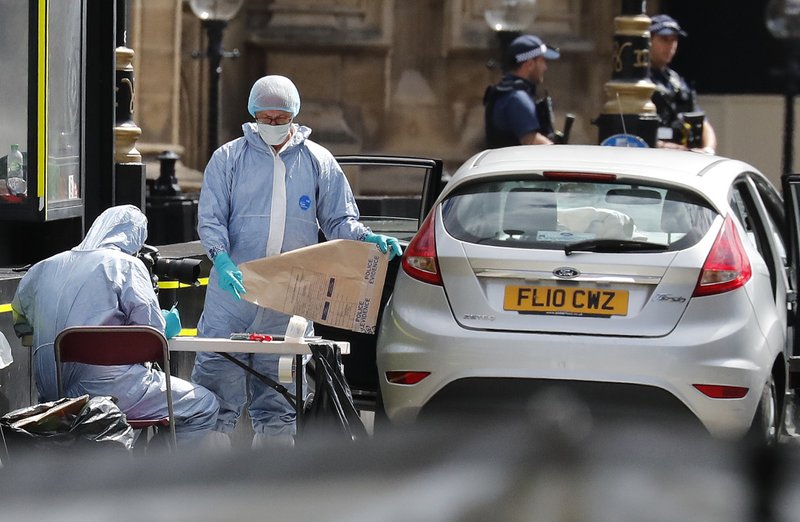LONDON -- Police flooded central London streets and cordoned off the government district Tuesday after a speeding car plowed into cyclists and crashed outside Parliament in what authorities were treating as an act of terrorism.
With the driver in custody, counterterror detectives were working to uncover the motive behind what they suspect is the fourth vehicle attack in Britain -- and the second on Parliament -- in 18 months.
"Given that this appears to be a deliberate act, the method and this being an iconic site, we are treating it as a terrorist incident," said Assistant Commissioner Neil Basu, Britain's top counterterrorism officer.
A rooftop camera recorded the silver Ford Fiesta driving past Parliament and suddenly veering sharply to the left, striking cyclists waiting at a set of lights, then crossing the road and crashing into a barrier outside Parliament. Armed police surrounded the car within seconds, pulling a man from the vehicle. Police said the driver was alone and no weapons were found in the car.
Three people were hurt, none critically.
Police arrested the 29-year-old driver, a resident of England's Midlands region who was not previously known to counterterrorism police or the intelligence services. Basu said the suspect was not cooperating with police.
Security Minister Ben Wallace said the man, whose name was not released, was a British citizen originally from another country.
Police said the car was driven from Birmingham in central England to London late Monday and was in central London for more than seven hours before the crash. Detectives were searching two properties in Birmingham and one in another Midlands city, Nottingham.
Police said they did not believe there was any ongoing threat from Tuesday's incident. After a meeting of the government's crisis committee, officials said Britain's terrorism threat level would remain at "severe," meaning an attack is highly likely. It has briefly been raised to the highest level, "critical," after some previous attacks.
Prime Minister Theresa May, who was on vacation in Switzerland, praised "the formidable courage of our emergency services and urged the public "to remain vigilant -- but also to come together and carry on as normal."
"The twisted aim of the extremists is to use violence and terror to divide us," May said in a statement. "They will never succeed."
Police cars and ambulances flooded London's government district just after 7:30 a.m., after witnesses reported seeing a silver car traveling at high speed hit pedestrians and cyclists, then crash into a barrier designed to protect Parliament from vehicle attacks.
Police shut the nearby Westminster subway station, and asked people to stay away from the area, which is filled with government offices and major tourist attractions, including Westminster Abbey.
The early morning scenes created a sickly sense of deja vu for many Londoners, whose city has been a target of violent attacks over the decades.
Last year alone, the city was hit by three deadly attacks. In March 2017, Khalid Masood plowed a car into crowds on Westminster Bridge, killing four people, then fatally stabbed a police officer before being shot dead in a courtyard outside Parliament.
Less than three months later, a van rammed into pedestrians on London Bridge before three men abandoned the vehicle and attacked weekend revelers in the nearby Borough Market. Eight people were killed and 48 injured.
In June 2017, a far-right extremist drove a van into a crowd of worshippers leaving a London mosque, killing one man and injuring eight others.
That attack followed the suicide bombing a month earlier at an Ariana Grande concert in Manchester that killed 22 people.
British authorities say the threat is not diminishing. Since March 2017, they have foiled 13 Islamist-inspired plots and four far-right plots, and currently have 676 live counterterrorism investigations, officials said Tuesday.
U.S. President Donald Trump tweeted that the crash was "another terrorist attack in London."
"These animals are crazy and must be dealt with through toughness and strength!" Trump added.
Tuesday's crash raised questions about security at Parliament, which has grown progressively tighter after previous attacks. Concrete and steel barriers protect against vehicle attacks, armed police officers patrol the grounds and visitors undergo airport-style security screening.
London Mayor Sadiq Khan said authorities would learn lessons from the latest incident.
"Just as the terrorists, the bad guys, evolve and find new ways to kill, to injure, to maim, to divide our communities, the police, the security services, the emergency services evolve and find ways to keep us safe," he said.
A Section on 08/15/2018

